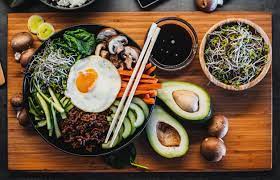Absolutely! The world of food is constantly evolving, driven by a combination of cultural shifts, technological advancements, and a growing awareness of health and sustainability. Let's take a journey through some fascinating culinary trends that have emerged and continue to shape the way we eat:
Evolution of Taste Buds
Food trends have significantly shaped cultures and lifestyles from ancient to modern times. Around 4000 BCE, ancient cultures developed unique culinary traditions in Mesopotamia.
The Discovery of Agriculture brought a significant shift as people ate with the cultivation of crops like wheat and barley. It became a staple and changed the way people nourished themselves.
Also, the spice trade shaped the world of cuisine, such as cinnamon, pepper, and cloves, added flavor, and preserved food.
11 Food Trends You Need To Know
As technological advancement evolves, so do the food trends. Check the popular food trends you might see in 2024.
1.Plant-Based Meat
Currently, plant-based meat has gained popularity as people become aware of the health benefits of a plant diet. Since companies invest in this growing market, plant-based meats will become mainstream in the next few years.

Pea protein, soy protein, and wheat gluten make these products. Its taste and texture are similar to meat but don't contain cholesterol, saturated fat, and hormones.
2.Plant-based Milk
From oat milk to flax and cashew milk, non-dairy milk isn't just for vegans. Milk substitute popularity is surging as consumers are concerned about the sustainability and environmental impact on animal welfare and dairy milk.
This milk isn't just for drinking but is also mixed into other products for making ice cream, chocolate, or coffee.
3.Functional Foods
Want additional health benefits beyond essential nutrition? Functional foods can do the job. They're fortified with vitamins, minerals, probiotics, or bioactive compounds having specific health-promoting properties. Functional foods include cereals, yogurt, omega-3-rich eggs, and vitamin D-fortified milk.
More food products have been promoted for their functional benefit. For example, blueberries contain high antioxidants, reducing inflammation and improving brain function. Turmeric, a popular cuisine spice, has curcumin, a compound with anti-inflammatory and antioxidant properties.
4.Fermented Foods
Fermented foods have become popular due to their unique flavor, texture, and health benefits. When microorganisms like bacteria, yeast, or fungi break down carbohydrates in foods, such as sugars and starch, into alcohol, it's called fermentation. It preserves the food and creates a tangy, savory, or sour taste.
Some fermented foods include kimchi, sauerkraut, kefir, kombucha, and miso. These foods aren't delicious but rich in probiotics.

5.Flexitarianism
Flexitarianism involves reducing the consumption of meat and animal products while allowing some flexibility and occasional food consumption. It also promotes a plant-based diet. Flexitarians can lower their carbon footprint by reducing meat intake. It causes chronic diseases like heart disease and diabetes.
6.Mushroom-based products
Mushrooms have been used in cooking for centuries, but you'll see creative and innovative uses in food. Mushroom-based products include mushroom jerky and mushroom burgers.
Besides this, you can add such versatile ingredients to various dishes, from stir-fries to stews, since these are rich in antioxidants, protein, and fiber. For a unique twist, it'll also be used in cooking and baking, such as mushroom powder as a seasoning or adding mushrooms to desserts.
7.Alternative flours
Alternative flours are made from grains and seeds, commonly used in traditional baking. They are gluten-free, making them a popular choice for people with gluten allergies.
You can use cassava flour instead of wheat or black bean flour as a protein-rich substitute.
So, alternative flours are worth checking out if you want to experiment with new and healthier ingredients in your cooking and baking.
8.Sustainable Seafood
With the rise of the adverse impact of fishing on the environment, people are looking for sustainable seafood options. Seafood is farmed through a technique that minimizes environmental harm and maintains healthy fish populations. Fishing methods include reducing bycatch, avoiding fishing in sensitive areas, and minimizing waste and pollution.
9.Indigenous Ingredients
Indigenous ingredients are native to a specific region or culture. Indigenous communities have used it for their nutritional and medicinal properties. Each has unique flavors, from traditional grains and fruits to herbs and spices.
These ingredients have a lower environmental impact than imported or non-native ingredients. So, more chefs and cooks incorporate indigenous elements into their cooking.
10.Low-alcohol beverages
As people look for healthier alternatives to traditional alcoholic drinks, these beverages get hype. Low-alcohol beverages hit the market with intelligent options. If you want to reduce your alcohol intake or try something healthier, sip non-alcoholic drinks.
11.Upcycled Foods
Upcycling transforms food waste or byproducts into new, edible products. It includes leftover ingredients to create new dishes. Upcycled foods reduce food wastage, promote sustainability, and create new economic opportunities. Food manufacturers and sustainability organizations promote upcycling.
Reasons for the Rise In Food Trends
The latest developments provide optimal solutions for a healthy body, planet, and sustainable future.
Sustainability
As the world heads towards a sustainable future, food manufacturers choose eco-friendly packaging materials such as biodegradable options to reduce waste. They also replace raw materials with EU-produced ones. Also, industries develop water treatment solutions to minimize water wastage in production processes.
Health & Wellness
Nowadays, consumers focus on improving their overall health and well-being. These concerns about health and wellness raise the demand for functional foods. From probiotic yogurt to fibers for a healthy gut, all have increased in popularity. Even beauty and UV supplement development grows due to customers' stress on skin tanning.
Conclusion
From alternative flours and indigenous ingredients to upcycled foods and low-alcohol beverages, plenty of exciting developments continue to happen in the food world this year. Whether you're a foodie, a chef, or someone looking to explore new culinary horizons, these trends might inspire you to try something new and delicious.


